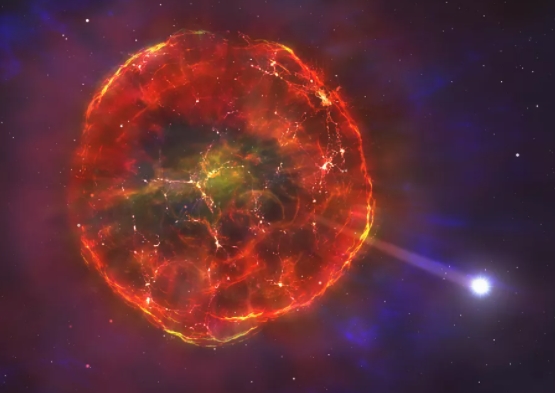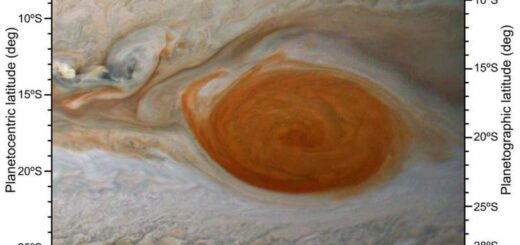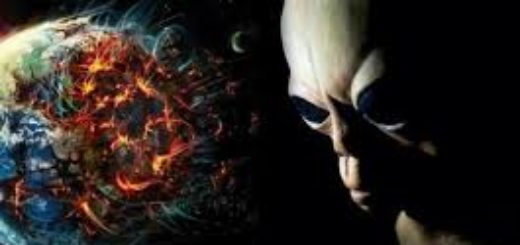Partial supernova’ blasts white dwarf star across the Milky Way

A strange white dwarf star hurtling through the Milky Way may be the survivor of a “partial supernova,” a new study finds.
White dwarfs are the cool, dim Earth-size cores of dead stars that are left behind after average-size stars have exhausted their fuel and shed their outer layers. Our sun will one day become a white dwarf, as will more than 90% of the stars in the Milky Way.
Previous research found that white dwarfs usually have internal structures arranged in layers. Their cores are mostly carbon and oxygen, which is usually surrounded by a layer of helium and then a layer of hydrogen. Astronomers examining white dwarfs usually see just hydrogen, just helium or sometimes a mix of helium and carbon (although there are exceptions that hint at unusual pasts.)
In a new study, scientists zeroed in on the white dwarf SDSS J1240+6710, located about 1,430 light-years from Earth. Discovered in 2015, prior work found this white dwarf had an unusual atmosphere that seemed to possess neither hydrogen or helium, but instead was composed of a weird mix of oxygen, neon, magnesium and silicon.
Researchers in this new study used the Hubble Space Telescope to take a closer look at the white dwarf and they identified carbon, sodium and aluminum in the object’s atmosphere. This mix sets this white dwarf apart from any other previously known, they said.
In this study, the scientists also found that the white dwarf was traveling about 560,000 miles per hour (900,000 kilometers per hour) in the opposite direction of the way the galaxy is rotating. Moreover, it had an especially low mass for a white dwarf — only about 40% the mass of our sun.
“When we found this unusual white dwarf was really low in mass and really moving fast, that really triggered my curiosity into what happened to it in its past,” study lead author Boris Gänsicke, an astrophysicist at the University of Warwick in England, told Space.com.
What might explain all these strange details about this white dwarf? The researchers in this study think that a thermonuclear explosion didn’t completely destroy the white dwarf but, rather, a “partial supernova” blasted what remained of the object across the Milky Way.
Supernovas are the most powerful star explosions in the universe, bright enough to momentarily outshine entire galaxies. They can occur when a white dwarf dies from siphoning off too much mass from a companion star. All the extra weight from the stolen mass squeezes the white dwarf’s core, which drives the core’s temperature and density high enough to set off a thermonuclear chain reaction that explosively obliterates the white dwarf.
In the case of SDSS J1240+6710, the scientists noted the elements seen in the white dwarf’s atmosphere could have all been produced in the first thermonuclear reactions of a supernova. However, there is a clear absence of what is known as the iron group of elements — iron, nickel, chromium and manganese.
These heavier elements are normally cooked up from lighter elements, and their absence in this white dwarf suggests it only went part of the way through a supernova, failing to reach the high temperatures and densities needed to forge iron-group elements.
“That’s what makes this white dwarf unique — it did undergo nuclear burning, but stopped before it got to iron,” Gänsicke said. “When it had its supernova event, it was likely just brief, maybe a couple of hours.”
The researchers suggested that SDSS J1240+6710 was small compared to white dwarfs that normally undergo thermonuclear supernovas. As such, only a miniature supernova may have occurred, a type Iax, a partial supernova weak enough to leave behind most of a white dwarf.
“In the old days, researchers would have thought a thermonuclear supernova would destroy a white dwarf entirely, but in the past 10 or 15 years, scientists have found it’s possible that a partial supernova could happen that leaves part of the white dwarf behind, burned and charred,” Gänsicke said. “The explosion isn’t powerful enough to totally disrupt the star.”
This explosion would have blasted SDSS J1240+6710 away from its companion, ripping matter off the small white dwarf and hurling it through deep space at the speed at which it orbited its partner, Gänsicke said. This scenario would help to explain the white dwarf’s speed, puny size and bizarre atmosphere.
Based on SDSS J1240+6710’s mass and temperature, the scientists estimated this partial supernova occurred about 40 million years ago. Much remains unknown about the white dwarf’s companion, but the researchers think it could have been a white dwarf much like SDSS J1240+6710.
Previous research into the origins of thermonuclear supernovas largely focused on larger white dwarfs. Now that this new study suggests that smaller white dwarfs can undergo similar explosions, future models could explore how these outbursts and their subsequent remnants might look, Gänsicke said.
“Thanks to the Gaia space mission, which was able to identify more than 50,000 white dwarf candidates, we can examine these white dwarfs to get a much better idea of what happens during these types of partial supernovas, such as what are the products of burning,” Gänsicke said. “Hopefully we’ll be able to identify a few dozen similar systems. We can start to go from one weird outlier to a small class of systems.”
Future research could also explore whether astronomers may have already detected the brief dim flashes of light Gänsicke and his colleagues suspect are linked with this kind of strange white dwarf.
“It will be interesting to see if they will be able to find these very short supernova-like events that likely were just dismissed until now because they didn’t look like supernovae,” Gänsicke said. “Since they were so short, the chances were very slim to catch one, and there was very little time to follow up on whether any such detection was real. But in principle, the data suggesting these events are real exists somewhere.”



 Creators of mankind
Creators of mankind Description of “Tall white aliens”
Description of “Tall white aliens” Where they came from?
Where they came from? About hostile civilizations
About hostile civilizations The war for the Earth
The war for the Earth “Tall white aliens” about eternal life
“Tall white aliens” about eternal life Video: “Nordic aliens”
Video: “Nordic aliens” Aliens
Aliens Alien encounters
Alien encounters The aliens base
The aliens base UFO
UFO Technology UFO
Technology UFO Underground civilization
Underground civilization Ancient alien artifacts
Ancient alien artifacts Military and UFO
Military and UFO Mysteries and hypotheses
Mysteries and hypotheses Scientific facts
Scientific facts


















